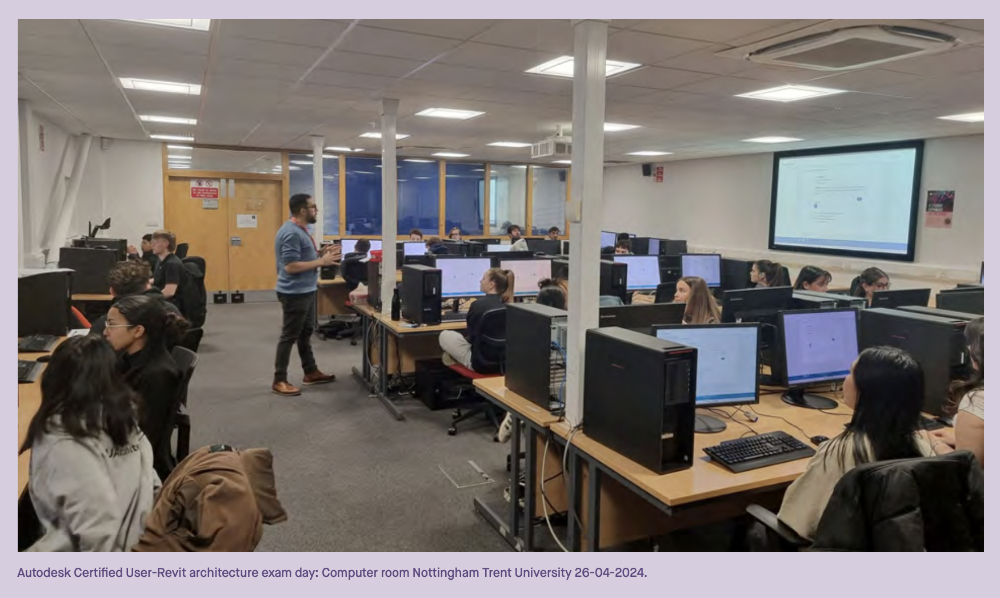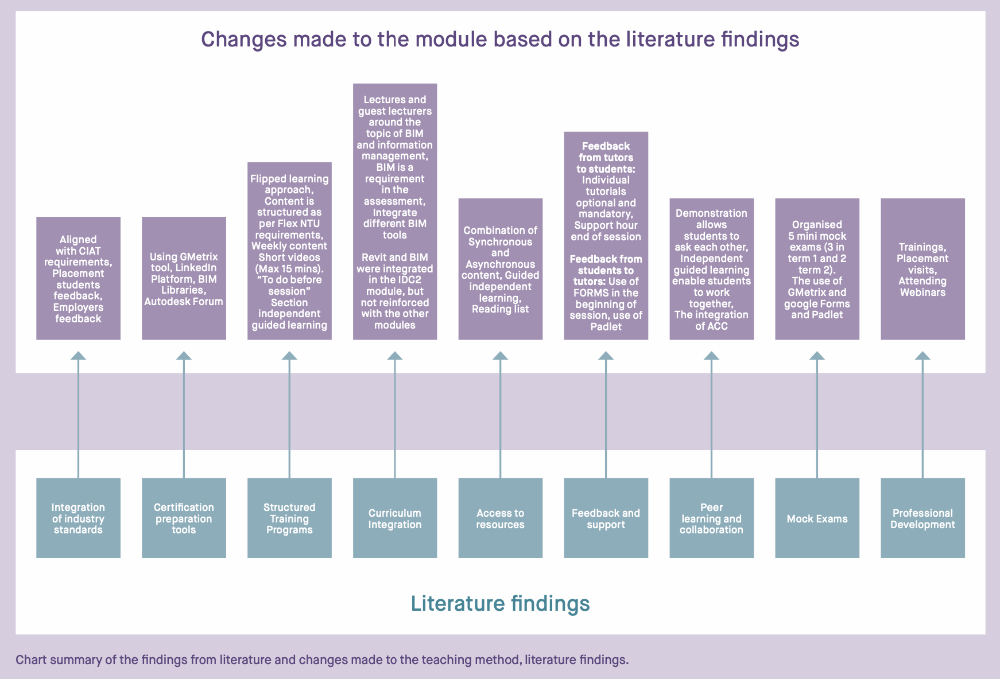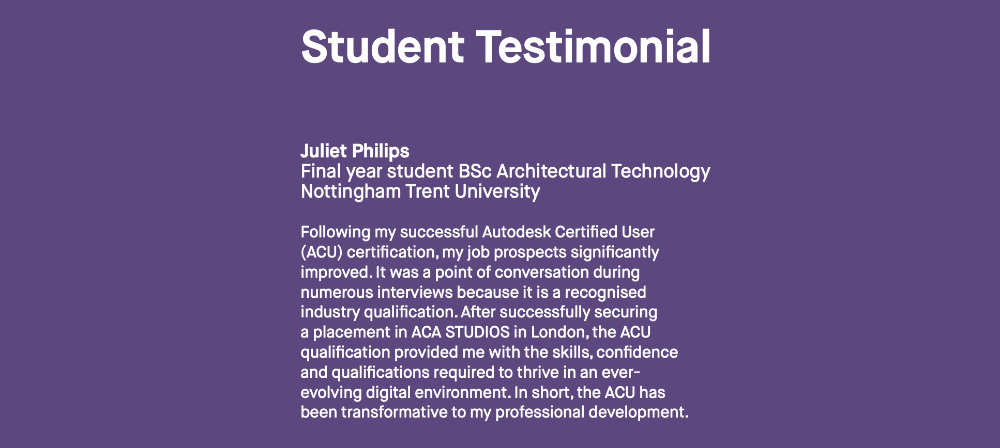Leveraging technology to enhance prospects for students
[edit] A case study on the significance of the Autodesk Revit certification
The Architectural Technology sector is continuously evolving, and as it does the demand for professionals who possess Building Information Modelling (BIM) skills and various industry-recognised certifications is significantly increasing.
In today’s highly competitive job market, employers have the luxury of choosing candidates who excel in challenging exams and possess relevant certifications. These can make a big difference. Autodesk certifications, specifically Autodesk Certified User and Autodesk Certified Professional for Revit Architecture, have become essential in helping Architectural Technology students obtain their desired placements and graduate roles. The certification also allows students obtain a badge that they can display on professional platforms such as LinkedIn, improving their visibility and interview prospects.
These certifications assure employers, showing that the candidate has completed a challenging exam that demands specific skills.
This article delves into the importance of BIM skills and the significance of the Autodesk Certified User for Revit Architecture certification. It presents the findings of two student surveys conducted to assess the impact of the certification on their confidence, development, focus, profile enhancement, and CVs. The survey also explored methods of enhancing teaching techniques and resources to improve students’ success rate.
Two questionnaires were developed and distributed to students to collect data. The first was filled in by Level 5 students after sitting the exam, giving feedback on teaching methods, the students’ experience, preparation tools and competencies. The second was taken by Level 6 students after they completed their placement. It aimed to assess how the certification boosted confidence during placement applications, as well as to assess professional growth and future recommendations. The first was distributed to fifty students, while the second was distributed to a cohort of thirty students.
Regarding their expectations prior to taking the exam, 64% of students said their initial expectation was that the certification was difficult. However, with effective teaching methods (as shown in the chart) a remarkable 90% of students successfully obtained their certificates.
Participants were asked to evaluate different software packages, including AutoCAD, SketchUp, and Revit, based on their personal preferences and suitability for their projects.
87.7% of respondents rated Revit as their top choice, underscoring its widespread favourability, suitability for various project needs and the significance of incorporating the Revit certification into educational curricula.
Participants were asked to evaluate how effective teaching techniques and resources were for Revit exam preparation and obtaining the certificate (results shown in the table). Evaluation of our findings led to us implementing various changes to teaching methods. These in turn have significantly contributed to increasing pass rates among Level 5 students.
An open-ended question asked for students’ advice for those preparing for the certification. They recommended a multifaceted approach involving instructional videos, consistent practice, and actively seeking clarification on uncertainties, which they preferred face-to-face.
In the second survey, when reflecting on their placements, 85% of participants indicated that their Autodesk Revit certification significantly bolstered their confidence, which helped them feel more prepared for the role. 70% of participants stated their Autodesk Revit certification had been significantly valuable for their career development and professional growth. A resounding 93% of respondents highly recommend obtaining the Autodesk Revit certification to fellow students pursuing a career in Architectural Technology.
When asked if they would be interested in pursuing the next step of Revit certification, which is Autodesk Certified Professional (ACP), 100% of students expressed keen interest in furthering their certification journey. This resounding enthusiasm illustrates the importance of these types of qualifications in career advancement and professional development.
We are excited to see what the future holds for the Autodesk Certified Professional (ACP). For our next steps, we are looking to embed ACP into our final year assessments in Digital Design and Building information management.
This article appears in the AT Journal issue 150, summer 2024 as 'Leveraging technology to enhance student prospects: a case study on the significance of the Autodesk Revit certification.' and was written by Dr Nacer Eddine Bezai and Bhavna Crossley, School of Architecture, Design, and the Built environment, Nottingham Trent University.
--CIAT
[edit] Related articles on Designing Buildings
- Appointing consultants.
- Architect.
- Architect's fees.
- Architectural assistant.
- Architectural design.
- Architectural styles.
- Architectural technician.
- Architectural technologist.
- Architectural training.
- CIAT articles.
- Consultant Team.
- Design and technology DT.
- Designers.
- Design methodology.
- How to become an architect.
- Manual drafting techniques.
- Professional Indemnity Insurance.
- Professional Qualifications Bill.
- RIBA National Schools Programme.
- School of Architectural Technology.
- The architectural profession.
- The role of architects.
- The future of architectural education.
Featured articles and news
Delivering for tenants; National Retrofit Hub
New report offers recommendations to strengthen energy efficiency standards to protect private renters.
Government consultations for the summer of 2025
A year of Labour, past and present consultations on the environment, the built environment, training and tax.
CMA competitiveness probe of major housing developers
100 million affordable housing contributions committed with further consultation published.
Homes England supports Greencore Homes
42 new build affordable sustainable homes in Oxfordshire.
Zero carbon social housing: unlocking brownfield potential
Seven ZEDpod strategies for brownfield housing success.
CIOB report; a blueprint for SDGs and the built environment
Pairing the Sustainable Development Goals with projects.
Types, tests, standards and fires relating to external cladding
Brief descriptions with an extensive list of fires for review.
Latest Build UK Building Safety Regime explainer published
Key elements in one short, now updated document.
UKGBC launch the UK Climate Resilience Roadmap
First guidance of its kind on direct climate impacts for the built environment and how it can adapt.
CLC Health, Safety and Wellbeing Strategy 2025
Launched by the Minister for Industry to look at fatalities on site, improving mental health and other issues.
One of the most impressive Victorian architects. Book review.
Common Assessment Standard now with building safety
New CAS update now includes mandatory building safety questions.
RTPI leader to become new CIOB Chief Executive Officer
Dr Victoria Hills MRTPI, FICE to take over after Caroline Gumble’s departure.
Social and affordable housing, a long term plan for delivery
The “Delivering a Decade of Renewal for Social and Affordable Housing” strategy sets out future path.
A change to adoptive architecture
Effects of global weather warming on architectural detailing, material choice and human interaction.
The proposed publicly owned and backed subsidiary of Homes England, to facilitate new homes.
How big is the problem and what can we do to mitigate the effects?
Overheating guidance and tools for building designers
A number of cool guides to help with the heat.
The UK's Modern Industrial Strategy: A 10 year plan
Previous consultation criticism, current key elements and general support with some persisting reservations.
Building Safety Regulator reforms
New roles, new staff and a new fast track service pave the way for a single construction regulator.






























